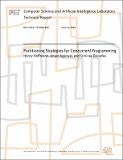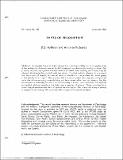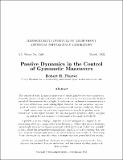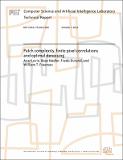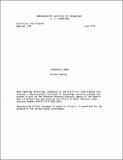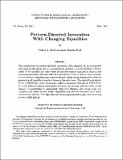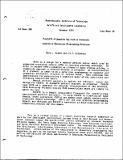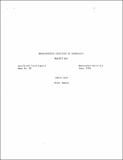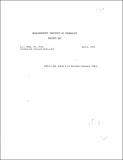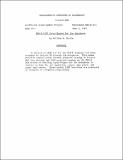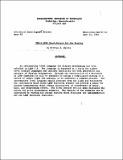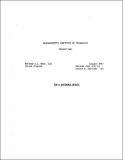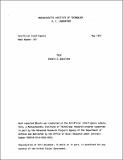Browsing Computer Science and Artificial Intelligence Lab (CSAIL) by Title
Now showing items 2471-2490 of 3804
-
Partitioned Garbage Collection of a Large Object Store
(1997-02)This paper describes a new garbage collection scheme for large persisten object stores that makes efficient use of the disk and main memory. The heap is divided into partitions that are collected independently using ... -
Partitioning Strategies for Concurrent Programming
(2009-06-16)This work presents four partitioning strategies, or patterns, useful for decomposing a serial application into multiple concurrently executing parts. These partitioning strategies augment the commonly used task and data ... -
Parts of Recognition
(1983-12-01)A complete theory of object recognition is an impossibility ??t simply because of the multiplicity of visual cues we exploit in elegant coordination to identify an object, but primarily because recognition involves ... -
Passive and Active Grasping with a Prehensile Robot End-Effector
(1990-05-01)This report presents a design of a new type of robot end-effector with inherent mechanical grasping capabilities. Concentrating on designing an end-effector to grasp a simple class of objects, cylindrical, allowed a ... -
Passive Dynamics in the Control of Gymnastic Maneuvers
(1995-03-01)The control of aerial gymnastic maneuvers is challenging because these maneuvers frequently involve complex rotational motion and because the performer has limited control of the maneuver during flight. A performer can ... -
Passive Navigation
(1981-11-01)A method is proposed for determining the motion of a body relative to a fixed environment using the changing image seen by a camera attached to the body. The optical flow in the image plane is the input, while the ... -
Patch complexity, finite pixel correlations and optimal denoising
(2012-10-07)Image restoration tasks are ill-posed problems, typically solved withpriors. Since the optimal prior is the exact unknown density of natural images,actual priors are only approximate and typically restricted to small ... -
Paterson's Worm
(1973-06-01)A description of a mathematical idealization of the feeding pattern of a kind of worm is given. -
Pattern Motion Perception: Feature Tracking or Integration of Component Motions?
(1994-10-01)A key question regarding primate visual motion perception is whether the motion of 2D patterns is recovered by tracking distinctive localizable features [Lorenceau and Gorea, 1989; Rubin and Hochstein, 1992] or by ... -
Pattern-Directed Invocation with Changing Equations
(1988-05-01)The interaction of pattern-directed invocation with equality in an automated reasoning system gives rise to a completeness problem. In such systems, a demon needs to be invoked not only when its pattern exactly matches ... -
Patterns in Trees
(1985-01)A very general enumeration formula for occurences of a pattern, or set of patterns, in the class of ordered trees with a given number of edges is presented, and its wide usefulness is demonstrated. -
PAZATN: A Linguistic Approach to Automatic Analysis of Elementary Programming Protocols
(1976-12-01)PATN is a design for a machine problem solver which uses an augmented transition network (ATN) to represent planning knowledge. In order to explore PATN's potential as a theory of human problem solving, a linguistic ... -
PDP-6 IAP
(1968-01-01)LAP is a LISP FEXPR (or FSUBR when compiled) which is executed primarily for its side effect??ely assembling a symbolic listing into core as a machine language subroutine. As such, it is about the most convenient and rapid ... -
PDP-6 LISP
(1966-06-01)This is a mosaic description of PDP-6 LISP, intended for readers familiar with the LISP 1.5 Programmer's Manual or who have used LISP on some other computer. Some of the newer features (e.g. the display) are experimental ... -
PDP-6 LISP (LISP 1.5) Revised
(1967-04-01)This is a mosaic description of PDP-6 LISP, intended for readers familiar with the LISP 1.5 Programmer's Manual or who have used LISP on some other computer. Many of the features, such as the display, are subject to ... -
PDP-6 LISP Input-Output for the Dataphone
(1965-06-01)A version of LISP 1.5 for the PDP-6 Computer has been extended to include IO through the dataphone. This makes possible communication between programs running in Project MAC time sharing and LISP programs running on the ... -
PDP-6 LISP Input-Output for the Display
(1965-06-01)An intermediate level language for display programming has been embedded in LISP 1.5 The language is intended as a basis for higher analysis of display information. Through the construction of a hierarchy of LISP functions ... -
PDP-6 Software Update
(1967-01-01)Conventions of this memo- Most numbers written in Arabic numerals are octal while all those written out in English are decimal. Underlying a character and immediately preceding it with a vertical bar indicates the character ... -
PDP-6 TECO
(1965-07-01)TECO is a scope-keyboard text- editor. It uses an on-line command language (which permits macro-definitions, corditional, etc.) as well as text operations. The macro language permits the most sophisticated search, ... -
PEEK
(1973-05-01)PEEK is a utility program designed to operate under the ITS time sharing system. It enables a user to monitor a variety of aspects of the time sharing system by providing periodically updated display output or periodic ...


